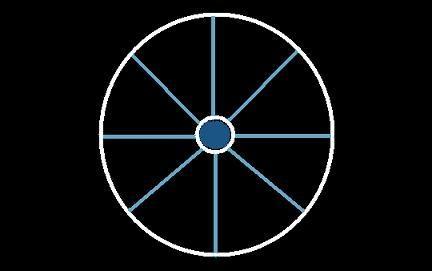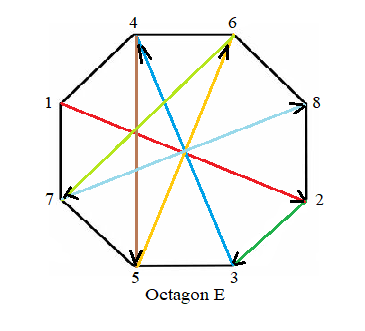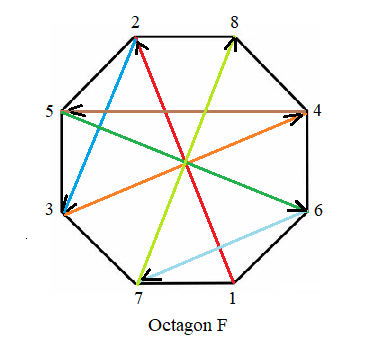Octagon Algorithm for Border Wheel Squares (Part V)
The Eight Node Way - 7×7 Squares
The previous section Part IV introduced the Octagon E and F algorithma for the construction of 5×5 Wheel Squares. This section will cover Wheel Border squares a topic which was discussed in 2015 using 7×7 squares. The method of construction, then, required using some little difficult to follow math. I have found a the Octagon method is a better way of tackling this problem which doesn't use math at all but employs directed graphs to fill in the non spoke cells. Border squares are magic squares whose internal lower number magic squares are also magic. As stated above, border squares can be constructed using the Wheel algorithm but with the wheel portion first constructed but in reverse order from that listed in Part II.
Thus, according to the discussion in Part I there are seven wheels which can be constructed for a 7th order wheel square. Some of these will be displayed, fully constructed, while two others will be constructed step by step using computer programs. All will use the 7×7 complementary table as a guide for picking the 25 wheel spoke numbers and the 24 non spoke numbers:
| 1 | 2 | 3 | 4 | 5 | 6 | 7 | 8 | 9 | 10 |
11 | 12 | 13 | 14 | 15 | 16 | 17 | 18 | 19 | 20 | 21 |
22 | 23 | 24 |
|
|
| 25 |
| 49 | 48 | 47 | 46 | 45 | 44 | 43 | 42 | 41 | 40 | 39 |
38 | 37 | 36 | 35 | 34 | 33 | 32 | 31 | 30 | 29 |
28 | 27 | 26 |
|
To fill in the non spoke numbers a new algorithm, Octagon E, is used starting with the initial node at the middle left node of the octagon:
The first three squares using the E algorithm are shown below, where 7(n) signifies a 7th order square with n as the number from column 1 of Table I from Part II.
Border Square 7(0)E
| 44 | 13 |
17 | 3 |
34 | 38 | 26 |
| 10 | 45 |
21 | 2 |
30 | 27 | 40 |
| 14 | 18 |
46 | 1 |
28 | 32 | 36 |
| 9 | 8 |
7 | 25 |
43 | 42 |
41 |
| 35 | 31 |
22 | 49 |
4 | 19 | 15 |
| 39 | 23 |
29 | 48 |
20 | 5 | 11 |
| 24 | 37 |
33 | 47 |
16 | 12 | 6 |
|
|
Border Square 7(1)E
| 42 | 13 |
17 | 5 |
34 | 38 | 26 |
| 1 | 43 |
21 | 4 |
30 | 27 | 49 |
| 14 | 18 |
44 | 3 |
28 | 32 | 36 |
| 11 | 10 |
9 | 25 |
41 | 40 |
39 |
| 35 | 31 |
22 | 47 |
6 | 19 | 15 |
| 48 | 23 |
29 | 46 |
20 | 7 | 2 |
| 24 | 37 |
33 | 45 |
16 | 12 | 8 |
|
|
Border Square 7(2)E
| 40 | 4 |
17 | 7 |
34 | 47 | 26 |
| 1 | 41 |
21 | 6 |
30 | 27 | 49 |
| 14 | 18 |
42 | 5 |
28 | 32 | 36 |
| 13 | 12 |
11 | 25 |
39 | 38 |
37 |
| 35 | 31 |
22 | 45 |
8 | 19 | 15 |
| 48 | 23 |
29 | 44 |
20 | 9 | 2 |
| 24 | 46 |
33 | 43 |
16 | 3 | 10 |
|
In addition, we can depict the squares 7(5)E and 7(6)E using colored border format:
Border Square 7(5)E
| 34 | 4 |
8 | 13 |
43 | 47 |
26 |
| 1 | 35 |
21 | 12 |
30 | 27 |
49 |
| 5 | 9 |
36 | 11 |
28 | 41 |
45 |
| 19 | 18 |
17 | 25 |
33 | 32 |
31 |
| 44 | 40 |
22 | 39 |
14 | 10 |
6 |
| 48 | 23 |
22 | 38 |
20 | 15 |
2 |
| 24 | 46 |
42 | 37 |
7 | 3 |
16 |
|
|
Border Square 7(6)E
| 32 | 4 |
8 | 15 |
43 | 47 |
26 |
| 1 | 33 |
12 | 14 |
39 | 27 |
49 |
| 5 | 9 |
34 | 13 |
28 | 41 |
45 |
| 21 | 20 |
19 | 25 |
31 | 30 |
29 |
| 44 | 40 |
22 | 37 |
16 | 10 |
6 |
| 48 | 23 |
38 | 36 |
11 | 7 |
2 |
| 24 | 46 |
42 | 35 |
7 | 3 |
18 |
|
We start by adding the lowest spoke number on the complementary table to position (1,0), i.e., position (row, column), on the square. For example, in 7(0)E, the first non spoke number, 10, goes into cell corresponding to node 1. Using the Octagon E, one follows the arrows and deposits a number into the appropriate white cell of the square. The difference between this algorithm and the previous ones is that the complements of the first four numbers no longer reside on the same row or column but reside across the octagon. Comparing the tuples of Octagon A from Part II with Octagon E, all tuples of A sum to 9 while E have sums of 8 and 10, respectively, as shown:
A (1,8),(7,2),(4,5),(6,3)
E (1,7),(8,2),(4,6),(5,3)
An alternative Octagon F, which has no edges superimposed onto the edges of the octagon, uses the following where node 1 is now at the bottom right of the octagon.
Border Square 7(0)F
| 44 | 11 |
15 | 3 |
36 | 40 | 26 |
| 37 | 45 |
19 | 2 |
32 | 27 | 13 |
| 33 | 29 |
46 | 1 |
28 | 21 | 17 |
| 9 | 8 |
7 | 25 |
43 | 42 |
41 |
| 16 | 20 |
22 | 49 |
4 | 30 | 34 |
| 12 | 23 |
31 | 48 |
18 | 5 | 38 |
| 24 | 39 |
35 | 47 |
14 | 10 | 6 |
|
|
Border Square 7(1)F
| 42 | 2 |
15 | 5 |
36 | 49 | 26 |
| 37 | 43 |
19 | 4 |
32 | 27 | 13 |
| 33 | 29 |
44 | 3 |
28 | 21 | 17 |
| 11 | 10 |
9 | 25 |
41 | 40 |
39 |
| 16 | 20 |
22 | 47 |
6 | 30 | 34 |
| 12 | 23 |
31 | 46 |
18 | 7 | 38 |
| 24 | 48 |
35 | 45 |
14 | 1 | 8 |
|
|
Border Square 7(2)F
| 40 | 2 |
15 | 7 |
36 | 49 | 26 |
| 46 | 41 |
19 | 6 |
32 | 27 | 4 |
| 33 | 29 |
42 | 5 |
28 | 21 | 17 |
| 13 | 12 |
11 | 25 |
39 | 38 |
37 |
| 16 | 20 |
22 | 45 |
8 | 30 | 34 |
| 3 | 23 |
31 | 44 |
18 | 9 | 47 |
| 24 | 48 |
35 | 43 |
14 | 1 | 10 |
|
The upshot is that both these algorithms along with the reversed wheel algorithm produce border squares, where the inner 3×3, inner 5×5 and outer 7×7 squares have magic sums of 75, 125 and 175, respectively.
Computer Coding for 7×7 Border Squares
Coding for these border squares is similar to those for the regular Octagon/Wheel squares, except on how the cells are filled. Programs 7aE and 7bE are the Octagon E series while programs 7cF and 7dF belong to the Octagon F series. Both programs use a step by step procedure for filling of the non spoke section portion of each square. The table gives two programs for both the Octagon E and F algorithms, and depend on how the numbers and complements are inserted into the square. In addition, both sets [(a) and (b)] and [(c) and (d)] give identical squares with the initial starting number.
This completes the Octagon E and F method for 7×7 squares.
Go to Part VI Go back to Part IV. Go back to homepage.
Copyright © 2022 by Eddie N Gutierrez. E-Mail: enaguti1949@gmail.com



